DOA 2019

DOA 2018

DOA 2012
Susana de Lorenzo: Voice and harmonium
Oscar Fernández: Hurdy-gurdy
Xoan Piñón: Acoustic and electric guitar

DOA 2012 from left side to right: Oscar Fernández, Susana de Lorezo and Xoan Piñón.
WORLD MUSIC CHARTS EUROPE JANUARY 2012
GLOBAL VILLAGE EE.UU. FEBRUARY 2012
RADIO NACIONAL RADIO EXTERIOR SPAIN MUNDOFONIAS "FAVORITOS 2011"
WORLD MUSIC CENTRAL EE.UU. "FINALIST 2011"
RNE5 RITMOS ETNICOS
MAGAZINE RHEIN-ZEITUNG GERMANY
MAGAZINE TITEL GERMANY
MAGAZINE LIRA SWITZERLAND
SOAS RADIO LONDRES "TOP TEN" 2011 ALBUMS
WORLD MUSIC.CO.UK BEST ALBUMS 2011
"XI PREMIOS OPINION MUSICA FOLK" BEST ALBUM 2011
+ info 1 + info 2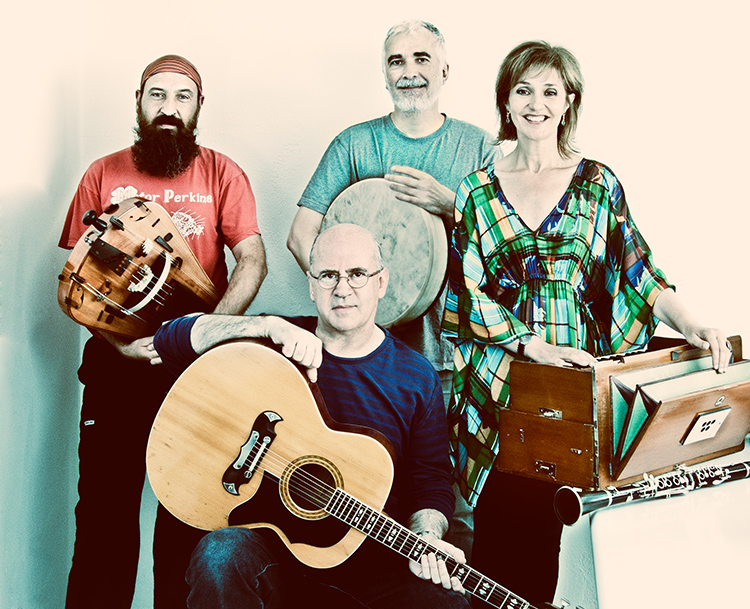
DOA 2011 from left side to right: Oscar Fernández, Bernardo Martínez, Xoan Piñón and Susana de Lorezo.
"GALICIAN FOLK CHRONICLES" TrisTram PUBLISHING HOUSE by Xoán Manuel Estévez and Óscar Losada
The late 70s were a period of continual releases. Everything was being done for the first time, even the formation of a local record industry: Ruada, a record company from A Coruña, was its main exponent, and the first piece in their catalog was an equally historic record, since, at the time, it worked as a bridge between the previous generation of Galician singers and another one made up of new musicians, who, with a high proportion of good will, transformed their passion into a struggle, in order to generate a movement that was then emerging. Along the way, the band DOA -to whom we are now referring- experienced an ongoing reconversion, through the presence of different members, to the extent that at the end of its first period none of the original band members remained in it.
It all began in A Coruña with two musicians: Xoán Piñón and Bernardo Martínez. Piñón's account of his experience can help us place ourselves in the right time and context:
From 1973-76 we composed and experienced with things like modal extemporized music, or "free-jazz", synthesized music... our background were bands like King Crimson, Hendrix... and also Renaissance and baroque classics: Bach, Haendel, Teleman, and so on. Later on, Enrique Ferreira -cello- joined Doa, which became a trio. In our first live concert as a band, we accompanied X. Quintas Canella and arranged his beautiful compositions. That was when we met Miro, who was preparing a record, and we offered him to work together as a band under the name of Doa after working as a quartet for about a year on O son da estrela escura, to which he contributed giving a new approach to the pieces. As a support for recording, Pedro Puértolas -a Catalan musician with a classical training-, who played violin, and Xaquín Blanco, a piper, joined us; whilst for live concerts, we played with Michel Canadá -also a violinist-, Francisco Luengo, a player of many instruments, and Luciano Pérez -bagpipe and hurdy-gurdy.
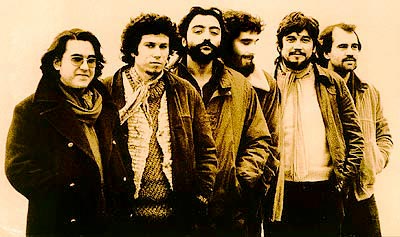
Live concert band members in "O son da estrela oscura" from left to right:
Francisco Luengo, Michel Canadá Enrique Ferreira, Bermardo Martínez,
Miro Casabella e Xoan Piñón
Again, a great deal of important figures, who would be later on highly praised on many occasions: Miro Casabella, far from being a newcomer, had developed a brilliant career as a singer, linked for some time to the band Voces Ceibes; and he will be individually mentioned later on; furthermore, M. Canadá eventually became a member of Milladoiro and F. Luengo the head of Capela Compostelana, -a band that showed preference for 17th and 18th century music-, whilst still belonging to the Grupo Universitario de Cámara de Compostela.
The first above-mentioned work of the band: O son da estrela escura -1979- meant the beginning of the handling of medieval repertoire, represented this time by different compositions by authors as representative as Alphonsus X -Festa de Loor-, Martín Códax -Cantiga V: the famous one referred to the sea of Vigo-, or an anonymous piece sung in French that emphasized the importance of the pilgrims' road to Santiago de Compostela in Southern France -La Pernette. To sum up, the recording was a kind of compendium that included Galician popular pieces, such as Danza do Rosal -from the area in Baixo Miño that bears the same name-, Danza das Espadas -in this case, from Pontevedra, but with a certain resemblance to others danced in Brittany and Provence-, Carballesa -a combination of pieces found in Melide and O Carballiño-, or Romance de Doña Ausenda -another anonymous piece, this time from the so-called Cilo Bretón-, and where the vocal interpreter: Miro Casabella.
In the King's gardens
There is a bewitched plant,
The woman who eats it
Becomes pregnant.
In the morning of Saint John's day
Doña Eusenda woke up early,
And in the King's gardens
Ate the bewitched plant.
Actually, in his previous period as a singer, this artist included the Romance... in his usual repertoire for live concerts. Therefore, Doa's emergence came to show that in the Galicia of the time this first outbreak of folk musicians kept some features in common with our recent music history.

DOA on tour in USA and Canada, from left to right:
Miro Casabella, Luciano Pérez, Xoan Piñón and Carlos Castro
At the beginning, the band members were: Bernardo Martínez -flutes, percussion-, Pedro Puértolas -violin-, Enrique Ferreira -cello-, above-mentioned Xoán Piñón -guitar, lute, mandolin- Xaquín Blanco -bagpipe, bombardon, percussion- and Miro Casabella -voice, hurdy-gurdy, zither- . This band was what can be considered the first Galician instrumental folk band, even though half of the pieces included in the record were sung. After the joining of musicians such as Baldo Martínez (double bass) and Manuel Varela (keyboard), the band left behind the vocal element in their internal structure, and became merely instrumental; although their second album, Polaridade -1984- had the collaboration of the famous Víctor Manuel, who was not only the producer of the recording, but also the singer of the well-known Baile de pandeiras. . However, by this time, Doa had already gone through a kind of reconversion, even though they never abandoned the traditional repertoire, which made them look for a sound that could be compared to the sound in the vanguard of the time -that is to say, ecm aesthetics, named after the prestigious German record company, closer to jazz than to anything else. This time, the musical sound effects elaborated and, above all, well combined, as well as certain special effects became materialized in instruments as new as the glockenspiel Carlos Castro was in charge of percussion. Another man, new in Doa but a veteran in the Galician scene, was Pepe Bordallo -electric bass-, and Javier Jurado, a musician from Córdoba, Southern Spain -transverse and soprano flute -, also joined the band. The only member who remained from the previous band was Xoán Piñón, even though the album had as collaborators Xaquín Blanco -bombardons and Galician bagpipe-, and Julio Blasco -double bass-. The quest for a sound that was then unusual in Galician music made this record the main reference of what was called progressive folk: a traditional repertoire with modern instruments. In this case, the versions were shocking -even today- due to their unusual timbre combination. There was only one original piece: Viva Ramón -Xoán Piñón- and all of the others were popular pieces, such as Ce fu en mai -with of French origin-, Resa med lekaré -Swedish-, Canción dos Piratas -German-, Forcarei -Galician-, as well as different versions of the famous Cantigas by Alphonsus the Wise. However, paradoxically, this kind of adventure was bound to fail at this period; the musicians were ahead of their time.
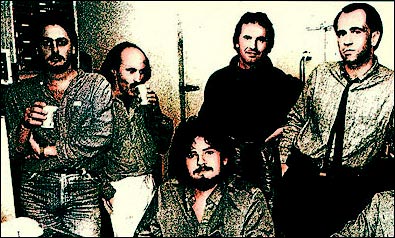
In the recording studio of "Polaridade", from left to righ: Carlos Castro,
Pepe Bordallo, Javier Jurado, Víctor Manuel and Xoan Piñón
From then on, Doa became a superband of individual figures, in spite of Miro's absence, since its members were experienced musicians, who had previously performed in bands such as Outeiro, which was closer to jazz-rock and included Bordallo. Otherwise, Carlos Castro, after a time in the vocal band Cumbre studied percussion, a subject that he would eventually teach in the Conservatorio Superior de Vigo; Javier Jurado was also a teacher, who then became Director of the Conservatorio de Ourense, and he was also involved in several choral experiences... . At that time, the academic world, traditionally restricted to the classical field, was beginning to come closer to the folk music scene through the work of some of these people.

From left to right: Carlos Castro, Baldo Martínez, Luciano Pérez Miro Casabella and Xoan Piñón
The struggle went on, and the band, already used to switching
members, recorded their third album: Perfiles -1986-.
On this occasion, the new musicians were Rubén Pérez
-guitars- and Manuel Varela -keyboard-, and the most
shocking element in the recording: the hand vibraphone
performed, again, by Carlos Castro. Can anyone picture
a piece from the Cancioneiro de Casto Sampedro played
with this instrument? The answer is in the piece that
gave name to the record, completed with other pieces
from other folklores; namely, the Portuguese, Vala
and Tempo do Antroido, the German, Allemande; the
voice of Amancio Prada accompanied the band in a
version of the famous Maio... In their previous recording,
they chose to break with the usual rules, but this time
concessions did not even include making themselves
understood by an audience who, in any case, was still
to be created. On this occasion, as on many others,
quality was not at all paralleled by celebrity. This
is why this question was asked to the band at the time,
and was answered by their occasional speaker, Javier Jurado:
How do you explain the relationship between
playing popular music and not being a too famous band?
I would stick to Bela Bartok's definition of popular
music: it is the one that has a traditional melodic basis,
from the people, but can be arranged in many ways,
even though it remains popular, whether it is done
by Bartok himself, Stravinsky... We are not a "folk"
music band in the traditional sense of the word, and
we are not Bartok, either, but we try to do good quality music.
Therefore, Doa's reconversion was a kind of test for the audience of the time, who did not digest well formulae such as the one that was repeatedly experienced in this album. To this, we need to add the difficulty of its stage design and the subsequent expenses it involved from an economic point of view - for example, an instrument such as the vibraphone-, so it is obvious how difficult their artistic survival became. They did not make people dance; concert dynamics of our root music had not yet been settled; however, the clichés that restricted the concept of popular to an elementary and simple music did work, with regard to the elementary and usual loud fun. In contrast, they chose a kind of experimental folk, later on continued by other musicians with different formulae. Doa are remembered for being forerunners, going ahead of the vogues without gaining a material profit from them. Time came to show the validity of a musician such as Carlos Castro, who seemed to be hunted by the band's music throughout his musical career, even though he was a versatile performer, being called by Fuxan os Ventos, for their return in the year 1999, and by Uxía, Saraibas and all sorts of musicians, who turned this A Coruña -born musician into a kind of long-distance runner of our music, in his multiple instrumental-percussion aspect; as it was eventually verified in the 90s
Along the way, the band Doa experienced such a strong reconversion that, at the end of this long period, none of the two original band members remained in it by the mid-80s, when it vanished from the artistic life.

"Arboretum", from left to right: Nora McEvoy, Xaquín Blanco, Bernardo Martínez e Xoan Piñón
Afterwards, they returned in the Festival Folk Cidade Vella de Santiago -1995-, with a spirit equal to that of the original band: acoustic sound and a more or less medieval repertoire. There were certain features that remained after their return, in the band's fourth album: Arboretum -2002-, an allegorical name -in Latin-, with which they tried to symbolize Galicia as a botanical garden. The promoters of Doa's return were, again, its legendary members Xoán Piñón -acoustic guitar, lute, mandolin, banjo, and arrangements- Bernardo Martínez -arrangements-, and Xaquín Blanco -Galician and Irish bagpipes, flutes, and Galician percussion-, who were joined by the Irish Nora McEvoy -violin-, Javier Ferreiro -percussion-, Francisco Luengo - tenor viol- Alfonso Morán -double bass-, Luciano Pérez -Organistrum-, Roberto Grandal -accordion-, to complete the core of this new recording, made with sounds equally inspired in the first period of the band: lute, mandolin, bagpipes, percussion, violin... for a repertoire where Galician popular pieces are the most outstanding. The album also includes two Cantigas de Sta. María and three original pieces -including an Irish reel-. This back to the beginning has been experienced by Xoan Piñón with the anticipation of a man who continues to undertake an already experienced ongoing journey:
As to the spirit of the album, I would say it exudes freedom; for example, we were loyal to the band's history. We worked without any pressure of time, money, vogues, record companies, and so on, and, just like the three previous ones, it will have a new style, new arrangements and new instruments.
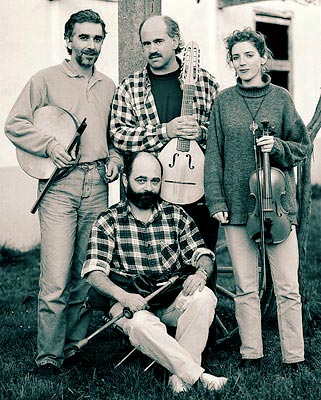
Original band members of the album "Arboretum", from
left to right: Bernardo Martínez, Xoan Piñón,Nora McEvoy,
Xaquín Blanco
DOA and Rosa Cedrón get together for the CANTIGALIA project. From Martín Códax to the Códice Calixtino, through the Cantigas de Santa María and the Romances by the Pilgrims' Road to Santiago de Compostela. Cantigalia is a project that absorbs the medieval spirit, which is impregnated with the peculiarity of its melodies and recaptures and conveys the splendour of those times in which Gallaecia was a cultural reference.
Once again, we will hear about the feelings of courtly love, cries for lovers that never return from the sea, guile and plots among peers, social accusations and even adventures including the walking stick to the Apostle, as in ancient times in country houses and castles
Furthermore, they show us the influence that survived in our folk range of topics in the course of centuries. They recapture treasures that never slept among noble people, but which have undoubtedly charmed the farmers that sang like them and settled down among them as traditional, keeping confidence under oath.
On the one hand, the innovative interpretation of folk and medieval music, together with Doa's hands' expertise, provide this adventure with the perfect balance between ancestral sounds and contemporary times, giving each note the sobriety needed, not forgetting the burden of the course of time.
On the other side, Rosa Cedrón, ensuring homogeneity with the best standard: the honest, transparent and seducing singing that crowns each piece making it unique. e seductor que corona cada tema facéndoo único e irrepetible.
MEMBERS
Xaquín Blanco: Bagpipe and flutes.
Rosa Cedrón : Voice and cello
Bernardo Martínez : Percussion and keyboards.
Xoan Piñón : Acoustic guitar.
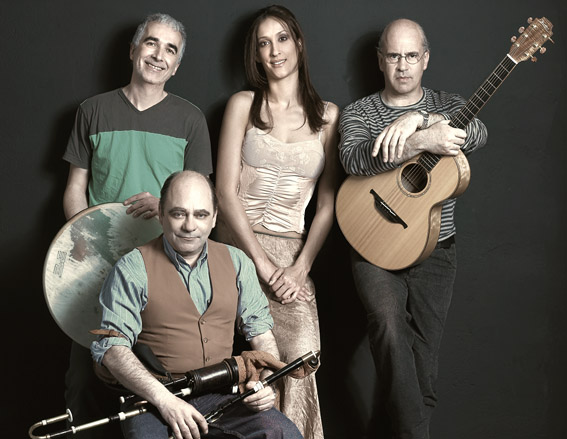
De esquerda a dereita:
Bernardo Martínez, Xaquín Blanco, Rosa Cedrón e Xoan Piñón
In 2009, the band DOA incorporated Susana de Lorenzo into its previous formation, "A fronda dos Cervos" the work -that was recorded in 2006 with the voice of Rosa Cedrón, mixed and mastered at the studio "Mare"- comes out again with new record, mixtures and arrangements.
In order to celebrate the centenary of "Luis Seoane"', the great Galician author and intellectual, DOA gave an "unplugged" concert at the Auditorium of the Corunna "Miguel González Garcés" Library on the 1st of June 2010, starting a new phase.
Band Members:Xaquín Blanco: Bagpipes, flutes and crumhorn Bernardo Martínez: Percussion, keyboards and musical production Xoan Piñón: Guitars and lute Oscar Fernández: Hurdy-gurdy
Musical collaborators:Rosa Cedrón: Voice Leilía: Voices
Other collaborators:Critical/literary study: Federico Pérez Prologue: Eva Veiga Graphic design: Miguel Pinheiro Voice Recording: Mare Documentation : Guillermo Escrigas
In 2009, the band DOA incorporated Susana de Lorenzo into its previous formation, "A fronda dos Cervos" the work -that was recorded in 2006 with the voice of Rosa Cedrón, mixed and mastered at the studio "Mare"- comes out again with new record, mixtures and arrangements.
In order to celebrate the centenary of "Luis Seoane"', the great Galician author and intellectual, DOA gave an "unplugged" concert at the Auditorium of the Corunna "Miguel González Garcés" Library on the 1st of June 2010, starting a new phase.
Band members:
Susana de Lorenzo: Voice
Xaquín Blanco: Uillean Pipe, flute, oboe
Bernardo Martínez: Drums
Xoan Piñón: Acoustic Guitar
Oscar Fernández: Hurdy-gurdy

DOA from left side to right: Xoan Piñón, Bernardo Martínez, Susana de Lorezo, Oscar Fernández and Xaquin Blanco.